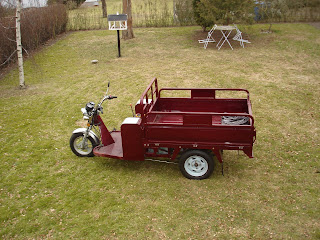Sorry for keeping you waiting, Even though I have not been writing on my blog lately I have done a lot of work on the electric car, both electric vehicle conversion work but also lots of car restoration work on bringing the car back to a road worthy condition at a minimal budget, later I will make a post about the restoration and my attempt at doing a professional repaint of the car back to its original colour.

But first things first:
Finally after spending the winter locked away in a garage somewhere in Odense I took my Trabant home to meet its new engine.

As I am a poor young man and home was only a few blocks away from the workshop, I pushed the car home, with the help of my dear strong mother, in order to save the expense of a tow truck. My warmest thanks go out to her for her involvement and help in my project.

When the car was safely home in my garage a new challenge emerged. How to get the electric motor hoisted safely down in place. The old Trabant engine was so light, that I could remove it by hand power, but the new motor was slightly heavier, this plus that I need to hold it suspended in order for me to measure for, and later install the motor mounts, which are going to keep the motor locked in place.
The solution:


Usually what most people recommend would be to use a standard engine hoist. But the cheapest of those cost 1200.- DKR and afterwards they take up a lot of space in the workshop, space which I simply does not have. So here is the solution: a home made crane, made out of scrap wood and a ladder with a 450.- DKR electric hoist bought at Bauhaus.

Was this "crane" safe one could ask?
Before I hoisted the motor with it I, weighing much more than the motor, climbed up on the plank holding all the weight and bounced it a bit. The contraption passed the test and I could move on and put it to use.
Redneck Ingenuity I think the Americans call it, This is the kind of thinking we need here in the financial crisis.

The adaptor plate was not a perfect fit, the shaft of the transmission and the shaft of the motor was not precisely aligned so I could hear a lot of friction noise. I guess measuring it from a piece of a cardboard is not precise enough; a couple of guys on YouTube used a piece of plexiglass which is probably a much better method.
However this is nothing that can’t be corrected. I just took out the transmission and placed it on top of my motor down in my workshop. I turned on the motor at 12 Volts and let it spin with the transmission on top, and then I moved the transmission around until all the friction noises was totally silenced. I put some clamps on to hold it in place and drilled some new holes in the adapter plate, put bolts in the holes and voila!
I did not have to fear that the bolts could just slip back into the old holes since I was kind of aware about the possible tolerance from measuring with cardboard back when I did the measuring so I asked the factory making the adaptor plate to make those holes smaller than the holes I would be ending up with for the bolts.

I would also point out that locating the correct alignment by sound was made allot easier because I had a brand new Kostov motor that did not produce much noise to distract me. if I had an old worn motor this method could have been more difficult to me.
After bumbling about with the motor and transmission a lot of the paint on the transmission got damaged so I chose to re paint it, but that is okay they do that all the time in American-Hotrod.
At the end it got back in the Trabant again, I tested it once again on the 12 volts jump-starter power supply and was able to move the Trabant in and out of the garage plus change gears and use the Clutch without any obstacle, even on a little 12 Volts 17 AH battery the car moved around smoothly.
A bottom frame holds the original two stroke engine in place with one big rubber mount. in the middle. As seen in the video about my electric motor I have a mount that goes around it with two holes at each side. So to acomodate this I bought two small rubber shock absorbers and fitted those to the motor mount of the electric motor.

Then liftet it up from touching the bottom frame using my crane and then fittet some pieces of metal to conect between them and the bottom frame that used to hold the original motor. I put it together with some dot welds then removed the rubber shock absorbers to protect them from the heat and started to solify my weldings.
Afterwards I masked the new mounts off and painted it in corotion resistant black paint, here is how it all looked at the end:

I am left with lot of confidence that this will turn out as a great electric vehicle once I get some traction batteries.
All this was videofilmed aswell, I wil upload that on another post.















